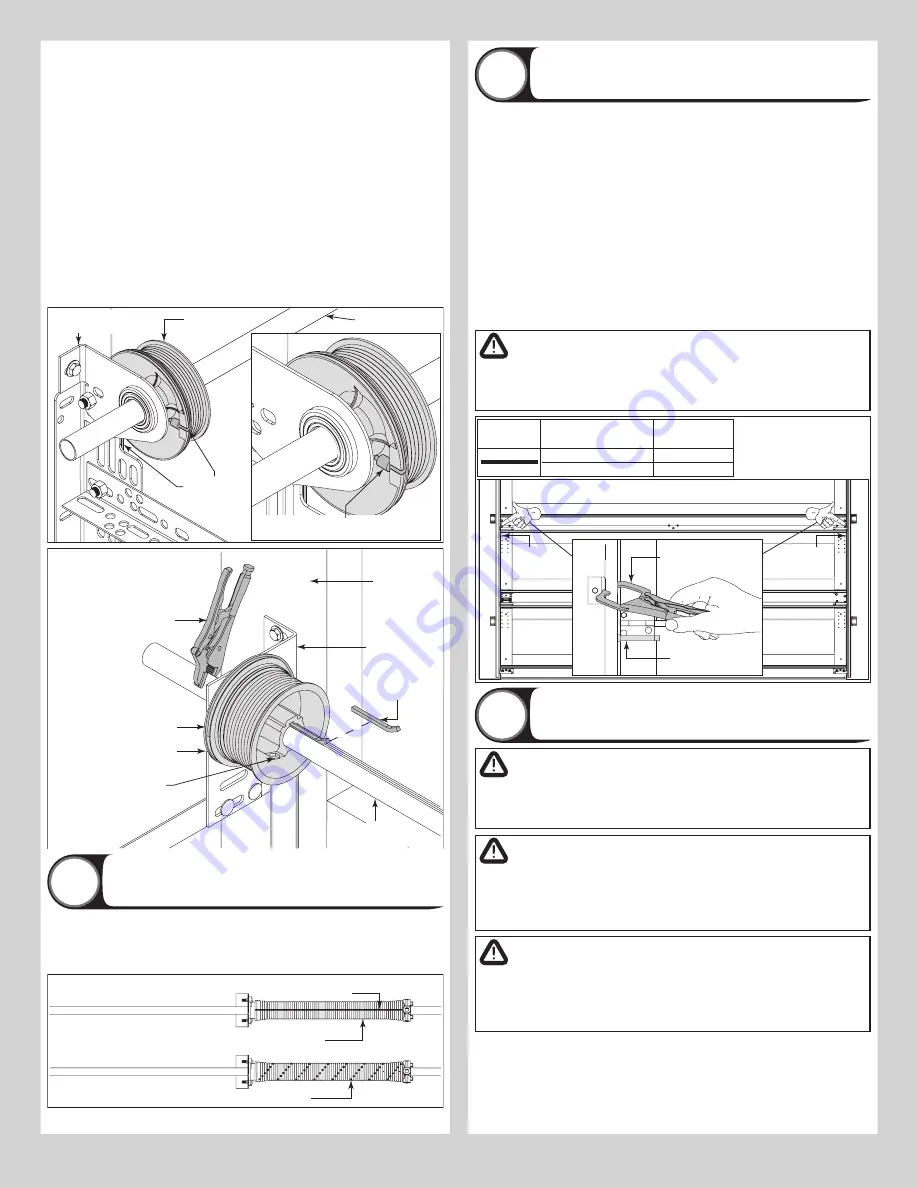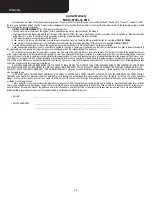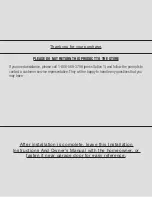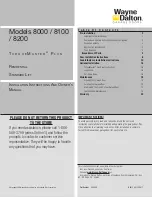
torque (once set screws contact the shaft, tighten screws one full turn).
NOTE:
If you have torsion keyed shaft(s), insert (1) key into the slot of both the cable drum
and the slot in the torsion keyed shaft, as shown.
Rotate the left hand drum and torsion shaft until counterbalance lift cable is taut. Now attach
locking pliers to the torsion shaft and brace locking pliers up against jamb to keep counter-
balance lift cable taut. Repeat for right hand side.
IMPORTANT:
INSPECT EACH COUNTERBALANCE LIFT CABLE MAKING SURE IT IS SEATED
PROPERLY ONTO THE CABLE DRUM AND THAT BOTH COUNTERBALANCE LIFT CABLES HAVE
EQUAL TENSION.
CHECK COUNTERBALANCE LIFT CABLES FOR EQUAL TENSION:
1. Attach locking pliers to track above top roller.
2. Grasp cable at approximate mid-door height location.
3. Draw cable toward you about 1/2” to 1” and release, noting the response of the cable.
4. Repeat above steps for other cable.
5. Adjust cable tension as needed until right and left cables both respond the same.
Once the counterbalance cables are set and if applicable tighten the coupler assembly
together by tightening the (3) 3/8” - 16 nylon hex nuts to secure the coupler halves together.
Counterbalance lift cable hooked in cable
drum
Counterbalance
lift cable
Typicall left hand
cable drum
Torsion shaft /
Torsion keyed shaft
Typicall left hand
end bearing bracket
Locking pliers
Set screws
Jamb
Key
Typicall left hand
cable drum
Torsion shaft /
Torsion keyed shaft(s)
Typicall left
hand end
bearing bracket
Counterbalance lift cable
hooked in cable drum
Chalking Torsion Spring(s)
19
NOTE:
If your springs have stenciling, then skip this step.
Draw a chalk line horizontally along the center of the torsion spring coil(s). As the torsion
spring is wound, the chalk line will create a spiral. This spiral can be used to count and
determine the number of turns that are applied on the torsion spring.
Draw horizontal chalk line prior to
winding
Spirals created after winding
Torsion spring
coils
Securing Door for Spring Winding
20
With the door in the fully closed position, place locking pliers onto both vertical tracks just
above the third track roller. This is to prevent the garage door from rising while winding
springs.
NOTE:
Check the following before attempting to wind torsion spring(s):
a. Counterbalance lift cables are secured at bottom corner brackets.
b. Counterbalance lift cables are routed unobstructed to cable drums.
c. Counterbalance lift cables are correctly installed and wound onto cable lift drums.
d. Counterbalance lift cables are taut and have equal tension on both sides.
e. Cable lift drums are against end bearing brackets and set screws are tight.
f. Torsion spring or springs are installed correctly.
g. Review the label attached to the spring warning tag, to determine number of spring turns
required.
NOTE:
Door MUST be closed and locked when winding or making any adjustments to the
torsion spring(s).
WARNING
FAILURE TO ENSURE DOOR IS IN A CLOSED POSITION AND TO PLACE
LOCKING PLIERS ONTO VERTICAL TRACK CAN ALLOW DOOR TO RISE
AND CAUSE SEVERE OR FATAL INJURY.
Winding Bars
(Steel Rods)
Size Of Winding Bar
(Inches)
Spring Inner
Diameter Used On
1/2” dia. x 18”
5/8” dia. x 24”
2” and 2-5/8”
3-3/4”
Locking pliers above
third track roller on
both sides of door
Bottom section
Lock
section
Locking pliers attached
to crown leg of vertical
track
Intermediate section
Vertical
track
Vertical
track
Winding Spring(s)
21
WARNING
WINDING SPRING IS AN EXTREMELY DANGEROUS PROCEDURE
AND SHOULD BE PERFORMED ONLY BY A TRAINED DOOR SYSTEM
TECHNICIAN USING PROPER TOOLS AND INSTRUCTIONS.
WARNING
USE ONLY SPECIFIED WINDING BARS, AS STATED IN STEP
SECURING DOOR FOR SPRING WINDING. DO NOT SUBSTITUTE WITH
SCREWDRIVERS, PIPE, ETC. OTHER TOOLS MAY FAIL OR RELEASE FROM
THE SPRING CONE AND CAUSE SEVERE OR FATAL INJURY.
WARNING
PRIOR TO WINDING THE SPRING, ENSURE YOU’RE WINDING IN THE
PROPER DIRECTION AS SHOWN BELOW. OTHERWISE THE SPRING
FITTING MAY RELEASE FROM SPRING AND RESULT IN SEVERE OR FATAL
INJURY.
Position a ladder slightly to the side of the spring so that the winding cone is easily acces-
sible, and so your body is not directly in line with the winding bars.
Check the label attached to the spring warning tag for the required number of complete turns
to balance your door.
HOW TO WIND TORSION SPRINGS:
1. Insert one winding rod snugly into winding cone, to full socket depth
15








































